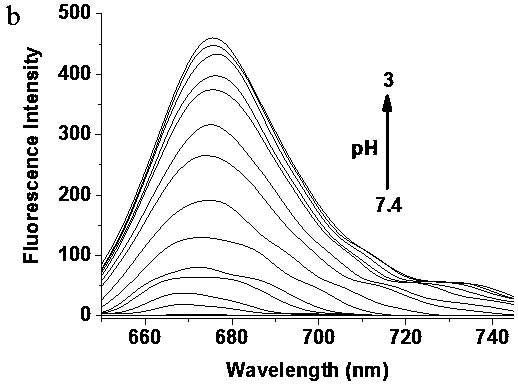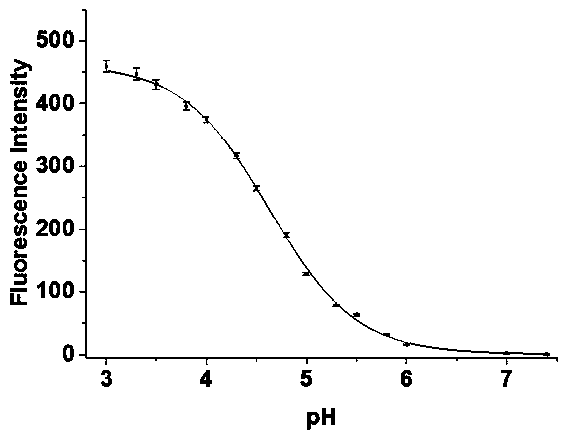Near infrared fluorescence probe for monitoring lysosomal pH as well as preparation method and application thereof
A fluorescent probe and near-infrared technology, applied in the field of analytical chemistry, can solve problems such as poor photostability and difficult fluorescent signals, and achieve the effects of easy synthesis, reduced background interference, and excellent photostability
- Summary
- Abstract
- Description
- Claims
- Application Information
AI Technical Summary
Problems solved by technology
Method used
Image
Examples
Embodiment 1
[0030] Synthesis of Fluorescent Probe Compound Lyso-NIR-pH
[0031] (1) Synthesis of Compound 1
[0032]At -78°C, under the protection of argon, 6g of 3-bromo-N,N-dimethylaniline and 60ml of anhydrous tetrahydrofuran were added to a dry 250ml round-bottomed flask, stirred magnetically for 5 minutes to dissolve, Subsequently, 13 milliliters of n-butyllithium n-hexane solution with a molar concentration of 2.4mol / L was added dropwise to the reaction solution, and after the dropwise addition was completed, it was reacted at 0°C for 2 hours, and then 2.2 milliliters of dichlorodimethylsilane was dissolved in 10 ml of anhydrous tetrahydrofuran, then added dropwise to the above reaction solution, after the dropwise addition, reacted to room temperature and stirred overnight, added 50 ml of water to quench the reaction, and extracted the reaction solution with ether (50 ml × 2). The extracted ether solution was washed with saturated NaCl aqueous solution (50 mL×3), anhydrous NaCl 2...
Embodiment 2
[0044] Determination of Fluorescent Spectrum of Fluorescent Probe Compound Lyso-NIR-pH under Different pH Conditions
[0045] Fluorescence spectra were measured in 40 mM Britton-Robinson buffer solution (containing 1% DMSO). The Lyso-NIR-pH fluorescent probe was dissolved in dimethyl sulfoxide (DMSO) to make a 500 μM stock solution. The test solution Lyso-NIR-pH (5.0 μM) was prepared by diluting the above 500 μM stock solution. The different pHs are obtained by adding small amounts of equal concentrations of HCl or NaOH. The test solution was stored at room temperature for 30 min, and the fluorescence spectrum was measured at an excitation wavelength of 620 nm. The fluorescence emission spectrum ranges from 640 to 800nm, the excitation slit is 3nm, and the emission slit is 3nm. Fluorescence spectra such as figure 1 As shown, when the pH value of the BR buffer is greater than 7.4, the probe Lyso-NIR-pH is almost non-fluorescent because it is a stable non-fluorescent helical...
Embodiment 3
[0047] Determination of UV-Vis Absorption Spectra of Fluorescent Probe Compound Lyso-NIR-pH at Different pH Conditions
[0048] figure 2 It is the ultraviolet-visible absorption spectrum of the probe Lyso-NIR-pH (5 μM) under the condition of pH 7.4-pH 3. from figure 2 It can be seen that as the pH decreases, a gradually increasing absorption peak can be observed at 655 nm. This indicates that the probe Lyso-NIR-pH responds to pH, and its helical ring structure is located at the proton H + The action is opened and the absorption increases. The instrument used for the determination of the UV-Vis absorption spectrum is a TU-1900 UV-Vis spectrophotometer (Beijing Purkinje General Instrument Co., Ltd.).
PUM
 Login to View More
Login to View More Abstract
Description
Claims
Application Information
 Login to View More
Login to View More - R&D
- Intellectual Property
- Life Sciences
- Materials
- Tech Scout
- Unparalleled Data Quality
- Higher Quality Content
- 60% Fewer Hallucinations
Browse by: Latest US Patents, China's latest patents, Technical Efficacy Thesaurus, Application Domain, Technology Topic, Popular Technical Reports.
© 2025 PatSnap. All rights reserved.Legal|Privacy policy|Modern Slavery Act Transparency Statement|Sitemap|About US| Contact US: help@patsnap.com



